Language Stimulation
Language stimulation is a set of interaction strategies that can be used in any context with children. Language stimulation is particularly useful for early communicators, and early language users.
But why do we need to know how to stimulate language in a child? Won’t they learn it naturally?
Sometimes they do… but sometimes they don’t, especially when there is a diagnosis of a language disorder.
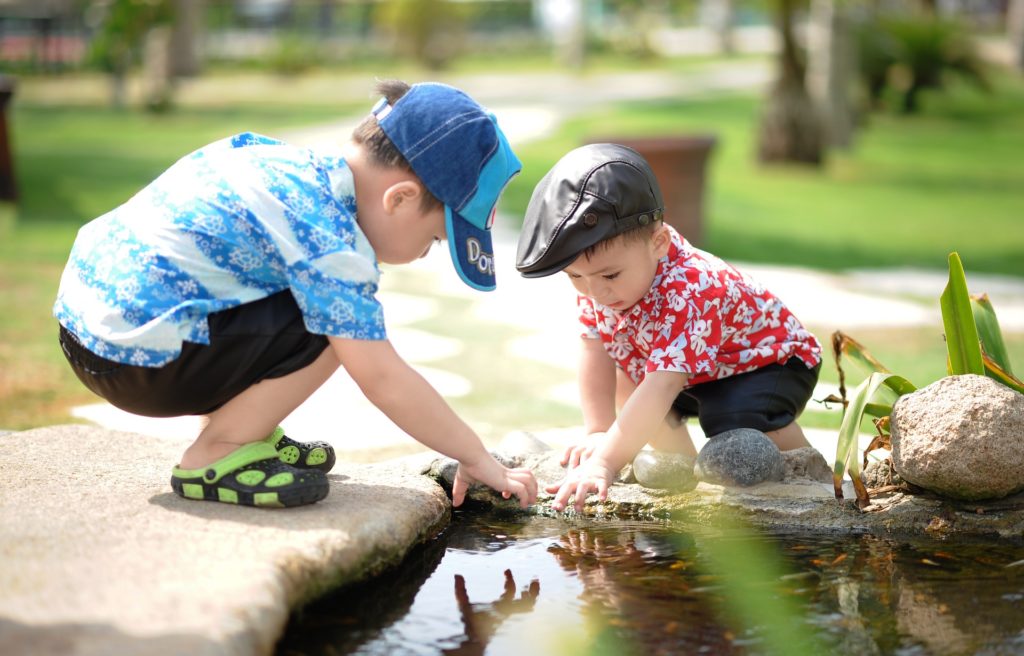
The American Speech-Language-Hearing Association (ASHA) has defined language disorders as an impairment in the “comprehension and/or use of a spoken, written, and/or other symbol systems”. Language disorders should only be diagnosed when it interferes with the child’s ability to meet societal expectations now or in the future. This could include difficulties with social relationships, academic achievement, and future employment prospects.
What is to be done then?
As a parent, you want to provide the best opportunities to your child to develop and reach his or her own potential. Professionals, such as speech pathologists, occupational therapists, psychologists and other educators will be there to help parents and the child in the journey ahead. But it is the parent who knows their child the best, who cares the most about their child and who is the most constant and important person in their child’s life.
As a parent, it is not easy to suddenly learn “language strategies” to stimulate speech and language in your child. So, what can be done to make it easier?
Interventions can be introduced to the child in a very natural way which involve the child’s day to day activities like meal time, bath time and story time. Practical strategies can be put into place to help children learn language naturally throughout their day together. This helps create enjoyable learning opportunities for the child.
Either naturalistic settings and activities or structured settings and activities can be chosen to stimulate the development of language. Some children may do better with one approach, while other children may do well with a different approach. The important thing is to be aware of the range of approaches available for planning intervention activities.
TRUST is the first thing that needs to be established between the child and the caregiver/facilitator. When using language stimulation, activities should be arranged in such a way that the child feel’s it is a natural part of play and interaction. From the child’s point of view, the activity is “just” play or conversation.
The next important aspect is following the child’s lead. Putting the child in the driver’s seat always drives the interaction forward. This is the best way to encourage the child to communicate and initiate an interaction. Every time the child leads an interaction and the parent/facilitator responds to them; they get more information about things that interest them – information they need to improve their communication. All children benefit from opportunities to see fun actions and objects mapped onto words in the context of exciting, familiar activities.
Video Link: https://www.youtube.com/watch?v=OqG3E7e-190
The Hanen Centre® (www.hanen.org) conducts parent training programs for those with children with developmental delays (It Takes Two To Talk®) and for those with children with Autism Spectrum Disorder (More Than Words®). They have shared some very useful strategies to help parents follow their child’s lead. Some of these strategies have been shared here too.
1. OWL or Observe, Wait and Listen
Observe – Watching your child closely in order to see the things that the child is interested in. These interests can then be included in what the two of you do together.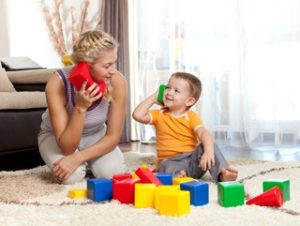
For example, on observing her son, a mother learns that her son prefers to hold the block like a telephone rather than use it for construction. Hence, mother picks up on this interest and pretends to use the block like a telephone too to continue the back and forth interaction.
Wait – Give your child enough time to send messages in their own way. While you may think at times that your child is not communicating at all… may be its because they are just not getting the chance to communicate.
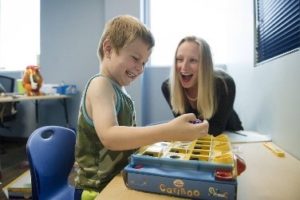
If you don’t rush in, the child will have a chance to do more than you may expect. Waiting can also give your child a chance to take in and think about what you are saying. If you ask your child a question and child does not answer right away, you might assume that your child does not understand the question and ask it again. However your second question may distract the child just as your child is about to make sense of the first one. All children take longer than adults to answer questions. It takes your child even longer. So wait atleast fifteen to thirty seconds or more for your child to respond. But be careful. It is possible to wait too long and have your child loose intrest. You have to fine tune your waiting to your childs level of persistance. Your waiting will bring about the best results when your child is motivated.
Listen – When you listen carefully to your childs sounds, words or sentences, you learn about what they can already do and what you can build upon. For example, if your child produces a lot of sounds with her lips, like “pah” and “bah”, you could emphasise motivating things that start with those sounds, like “park” and “ball”.

When your child first starts to talk, they may not speak clearly. If your child says “ow” every time when standing near the door, there is a strong possibility that the child is trying to say “out”. If you listen carefully, you can respond to “ow” by saying, “Out. Lets go out”. This will give him/her a model of the correct pronunciation of the word.
2. Face to Face
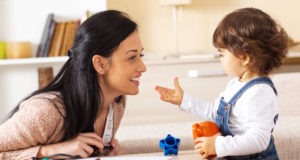
When a parent positions themselves face-to-face with their child, they will be bale to see what their child is interested in. By placing themselves at the child’s level, they become a part of the child’s world. This helps the child to notice the smiles, frowns, eye movements that say as much as words (broadband communication).
3. Self-talk and parallel talk
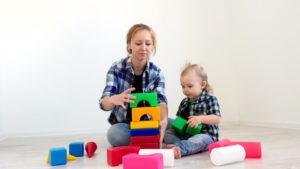
In self-talk, we describe our own actions as we engage in parallel play with the child. If the child is building a block tower, we copy the tower with our own blocks, saying as we do, “Up. Blocks go up up. See my blocks? I’m building the blocks up.”
Self-talk provides a clear and simple match between actions and words. By using the child’s actions and matching our own words and actions to them, we model how to comment on our actions with language. By using self-talk, you will teach your child new words about their environment and daily routines.
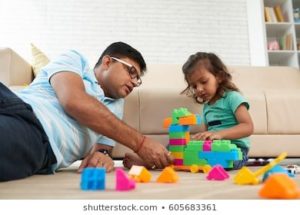
In parallel talk, we provide self-talk for the child. Instead of talking about our own actions, we talk about the child’s, providing a running commentary, something like the play-by-play at a sporting event. To take the same block-building example we used before, parallel talk might sound like, “Blocks go up! You put on a block. Another block goes up. Now it’s big! You’re building a big tower!” By using parallel talk, you are producing a conversation about what your child is doing and this will enrich their vocabulary and concept awareness.
Video Link: https://www.youtube.com/watch?v=CKowaBkSm9A
4. Imitations

Imitation is an important skill that is used to acquire new words, word formations, and semantic structures. We often ask a child to imitate us during the stimulation. But instead, we can turn the tables and imitate what the child says/does. Research suggests that children who imitate show advances in language development (Carpenter, Tomasello, & Striano, 2005). We can copy child’s sounds, actions and facial expressions. We can use the child’s imitation to initiate a repeated back-and- forth exchange that will help the child develop this basic turn-taking structure for conversation. For example, if a child is playing with a toy drum and says “oo,” you can take the toy and imitate the same motion by saying “oo” back. The child is now aware that you want to play.
5. Sabotage/Creative Stupidity
Make mistakes “accidentally”! Children love it when their parents make mistakes. So, do something silly and your child will usually pay attention to you then.
For example, when you are helping your child with brushing his teeth, instead of giving him the paste to put on the toothbrush, “accidentally” give him the soap! This provides the child with an opportunity to first notice that something is wrong and then an opportunity to communicate with you about your “silly” mistake!
Video Link: https://www.youtube.com/watch?v=9d0sP2Wb7hw
6. Expansions

Expansion refers to adding one or more words to what your child says when you respond back. We take what the child said and add the grammatical markers and semantic details. For example, if your child, “bird” you might expand on this one-word utterance by saying “Yes! Blue bird”. If your child then says “bird up” you might expand and say, “Blue bird is up in the tree”. This is a great way to get them to say more and simultaneously build language. Expansions have been shown to increase the probability that a child will spontaneously imitate at least part of the expansion (Scherer & Olswang, 1984).
7. Recast sentences
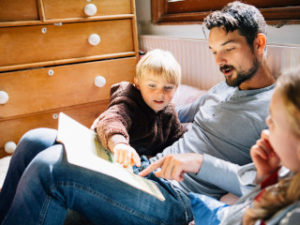
These are similar to expansions. Expansions, elaborate the child’s utterance into a grammatically correct version of the intended sentence type. In recasting, we expand the child’s remark into a different type or more elaborated sentence.
If the child makes the statement “doggy house,” we can recast it as a question, “Is the doggy in the house?” or a negative sentence (used as a playful denial of the child’s utterance), “The doggy is not in the house!” or even a statement, “The doggy is in the house. He’s asleep!”
Video Link: https://www.youtube.com/watch?v=wD9TTtA3wKE
8. Extensions
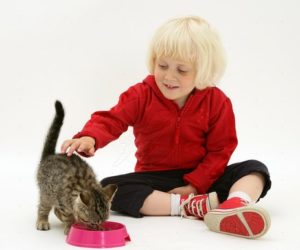
These are comments that add some semantic information to a remark made by the child.
For example, if the child says, “Kitty eat”, then we can say, “The kitten is hungry”.
Cazden (1965) and Barnes, Gutfreund, Satterly, and Wells (1983) showed that adults’ extensions are associated with significant increases in children’s sentence length.
In summary – your child will learn to communicate with you when he or she:
- Pays attention to you
- Finds enjoyment in 2-way communication
- Copies the things you do and say
- Understand what others say
- Interacts with other people
- Has fun!
- Practices what he or she learns often
- Has structure, repetition and predictability in his or her life
References:
- It Takes Two To Talk – Jan Pepper and Elaine Weitzman
- More Than Words – Fern Sussman
- Carpenter, M., Tomasello, M., & Striano, T. (2005). Role reversal imitation and language in typically developing infants and children with autism. Infancy, 8(3), 253-278.
- Scherer, N. J., & Olswang, L. B. (1984). Role of mothers’ expansions in stimulating
- children’s language production. Journal of Speech, Language, and Hearing Research, 27(3), 387-396.
- Cazden, C. (1965). ENVIRONMENTAL ASSISTANCE TO THE CHILD’S ACQUISITION
- OF GRAMMAR.
- Barnes, S., Gutfreund, M., Satterly, D., & Wells, G. (1983). Characteristics of adult speech which predict children’s language development. Journal of child language, 10(1), 65-84.
- Paul, R., & Norbury, C. F. (2012). Language disorders from infancy through adolescence. St. Louis (MO: Elsevier Health Sciences.
- Pennington, L., Thomson, K., James, P., Martin, L., & McNally, R. (2009). Effects of It Takes Two to Talk—The Hanen Program for parents of preschool children with cerebral palsy: Findings from an exploratory study. Journal of Speech, Language, and Hearing Research.
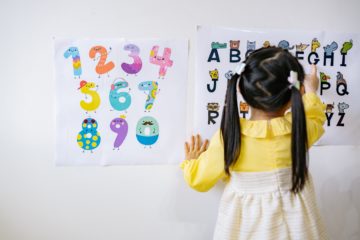
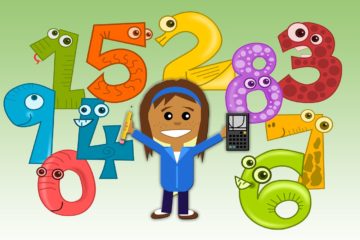
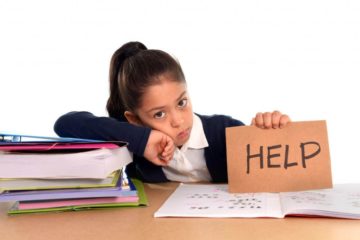
0 Comments